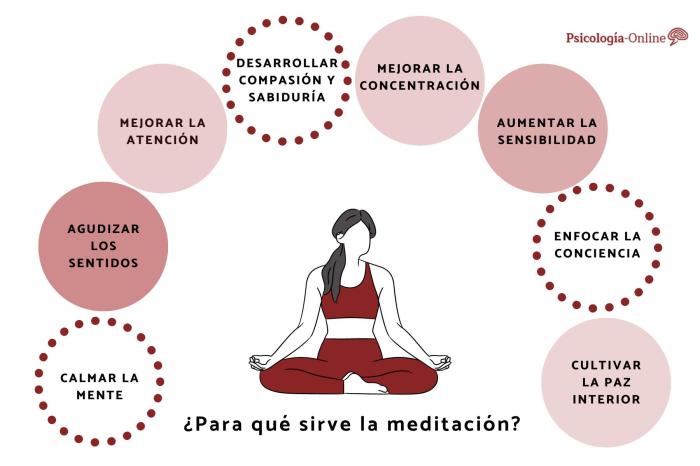10 Tips for Setting Up a Meditation Routine – Embark on a journey through the 10 essential tips for setting up a meditation routine, exploring the profound benefits and practical techniques to enhance your well-being and focus.
Discover how creating a dedicated meditation space, choosing the right technique, and establishing a consistent routine can transform your mental clarity and overall health.
Benefits of Meditation

Meditation is a powerful practice that offers a wide range of benefits for both the mind and body. Establishing a regular meditation routine can lead to significant improvements in various aspects of your life.
Improved Mental Clarity and Emotional Well-being
Meditation helps calm the mind, reduce racing thoughts, and enhance mental clarity. By practicing meditation regularly, individuals can experience increased focus, concentration, and a greater sense of inner peace. This, in turn, can lead to improved emotional well-being, helping individuals manage their emotions more effectively and cultivate a positive outlook on life.
Stress Reduction and Overall Health
One of the most well-known benefits of meditation is its ability to reduce stress levels. By practicing mindfulness and deep breathing techniques, individuals can lower their cortisol levels and combat the harmful effects of chronic stress on the body. This can result in improved overall health, including better sleep quality, reduced inflammation, and a stronger immune system.
Enhanced Focus and Productivity
Through regular meditation, individuals can train their minds to focus on the present moment, increasing their ability to concentrate on tasks and projects. This heightened focus can lead to increased productivity, better decision-making, and a greater sense of accomplishment in both personal and professional endeavors.
Setting Up a Meditation Space

Creating a dedicated meditation space can significantly enhance the quality of your practice. A serene and distraction-free environment can help you focus and deepen your meditation experience. Here are some tips on setting up the perfect meditation space.
Choosing the Right Location
When selecting a location for your meditation space, opt for a quiet area where you won’t be disturbed. Choose a spot with natural light if possible, as it can create a calming atmosphere. If natural light is not available, consider soft, warm lighting to set the mood.
Comfortable Seating and Proper Lighting
Comfort is key when it comes to meditation. Invest in a comfortable cushion or chair that supports your posture and allows you to sit for an extended period without discomfort. Additionally, ensure proper lighting that is not too harsh or dim. Soft, ambient lighting can help create a relaxing ambiance for your practice.
Incorporating Elements of Nature
Bringing elements of nature into your meditation space can enhance the overall experience. Consider adding indoor plants for a touch of greenery and a sense of tranquility. You can also incorporate soothing decor such as candles, essential oils, or natural materials like wood or stones to create a peaceful atmosphere.Remember, your meditation space should be a reflection of your personal preferences and needs.
Experiment with different elements until you find what works best for you in creating a calming and inviting environment for your practice.
Choosing a Meditation Technique

When it comes to starting a meditation practice, choosing the right technique is essential to ensure that it aligns with your preferences and goals. There are various meditation techniques available, each with its own unique benefits and approaches. Here, we will explore some of the most popular types of meditation techniques to help you find the one that resonates with you.
Mindfulness Meditation
Mindfulness meditation involves focusing on the present moment without judgment. It encourages awareness of thoughts, feelings, and sensations as they arise, allowing you to observe them without getting caught up in them. This technique is beneficial for reducing stress, improving focus, and cultivating a sense of inner peace.
Transcendental Meditation
Transcendental meditation involves the use of a mantra to transcend ordinary thinking and reach a state of pure awareness. This technique is known for its ability to promote relaxation, reduce anxiety, and enhance overall well-being. It is often practiced for 20 minutes twice a day while sitting with closed eyes.
Loving-Kindness Meditation
Loving-kindness meditation focuses on cultivating feelings of love, compassion, and goodwill towards oneself and others. This technique involves repeating phrases or mantras that evoke feelings of kindness and empathy. It can help improve relationships, enhance self-compassion, and foster a sense of interconnectedness with others.
Choosing the Right Technique
When selecting a meditation technique, consider your goals and preferences. If you prefer a structured practice, mindfulness meditation might be a good fit. If you seek to deepen your spiritual connection, transcendental meditation could be beneficial. For those looking to cultivate compassion and empathy, loving-kindness meditation might be the way to go.
Experimenting with Techniques, 10 Tips for Setting Up a Meditation Routine
It’s important to experiment with different meditation techniques to find the one that resonates with you the most. Try practicing each technique for a few days or weeks and pay attention to how you feel during and after each session. Remember that there is no one-size-fits-all approach to meditation, so don’t be afraid to explore and find what works best for you.
Establishing a Routine

Establishing a consistent routine for your meditation practice is crucial for reaping the full benefits of this ancient practice. By setting a regular schedule, you can create a habit that becomes second nature over time, making it easier to stick to your practice.
Setting a Schedule
- Choose a time of day that works best for you, whether it’s first thing in the morning, during your lunch break, or before bed.
- Try to meditate at the same time each day to establish a routine and make it a non-negotiable part of your day.
Ideal Duration and Frequency
- Start with short sessions, such as 5-10 minutes, and gradually increase the duration as you become more comfortable with the practice.
- Aim for meditating at least once a day, but don’t be discouraged if you miss a session – just make an effort to get back on track the next day.
Overcoming Obstacles
- Identify potential obstacles that may prevent you from meditating regularly, such as lack of time or distractions, and find solutions to address them.
- Set reminders on your phone or calendar to help you remember to meditate, and create a dedicated space for your practice to minimize distractions.
Gradual Progression
- As you become more comfortable with your meditation practice, consider increasing the duration of your sessions or trying more advanced techniques to deepen your practice.
- Listen to your body and mind, and don’t push yourself too hard – gradual progression is key to building a sustainable meditation routine.
Mindful Breathing Techniques: 10 Tips For Setting Up A Meditation Routine

Breathing is an essential part of meditation as it helps anchor your awareness to the present moment. Focusing on the breath can promote relaxation, reduce stress, and enhance mindfulness. Here are some mindful breathing techniques to incorporate into your meditation practice:
1. Deep Belly Breathing
Begin by sitting or lying down in a comfortable position. Place one hand on your chest and the other on your belly. Inhale deeply through your nose, allowing your belly to rise as you fill your lungs with air. Exhale slowly through your mouth, feeling your belly fall. Repeat this for several breaths, focusing on the sensation of your breath moving in and out of your body.
2. Box Breathing
This technique involves breathing in four equal parts: inhale, hold, exhale, hold. Start by inhaling deeply for a count of four, hold your breath for a count of four, exhale for a count of four, and then hold your breath again for a count of four. Repeat this cycle for several rounds, maintaining a steady rhythm.
3. Alternate Nostril Breathing
Sit comfortably with your spine straight. Use your right thumb to close off your right nostril and inhale deeply through your left nostril. Close off your left nostril with your ring finger, exhale through your right nostril. Inhale through the right nostril, then close it off and exhale through the left. Continue this pattern for a few minutes, focusing on the flow of breath.
Final Review
In conclusion, integrating these 10 tips into your daily life can lead to a profound shift in your well-being and productivity, paving the way for a more mindful and balanced existence.